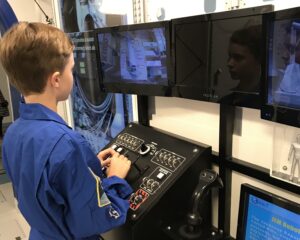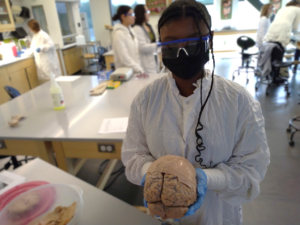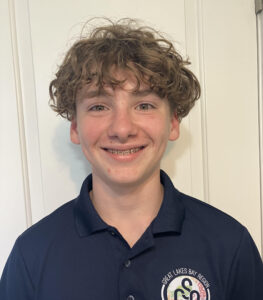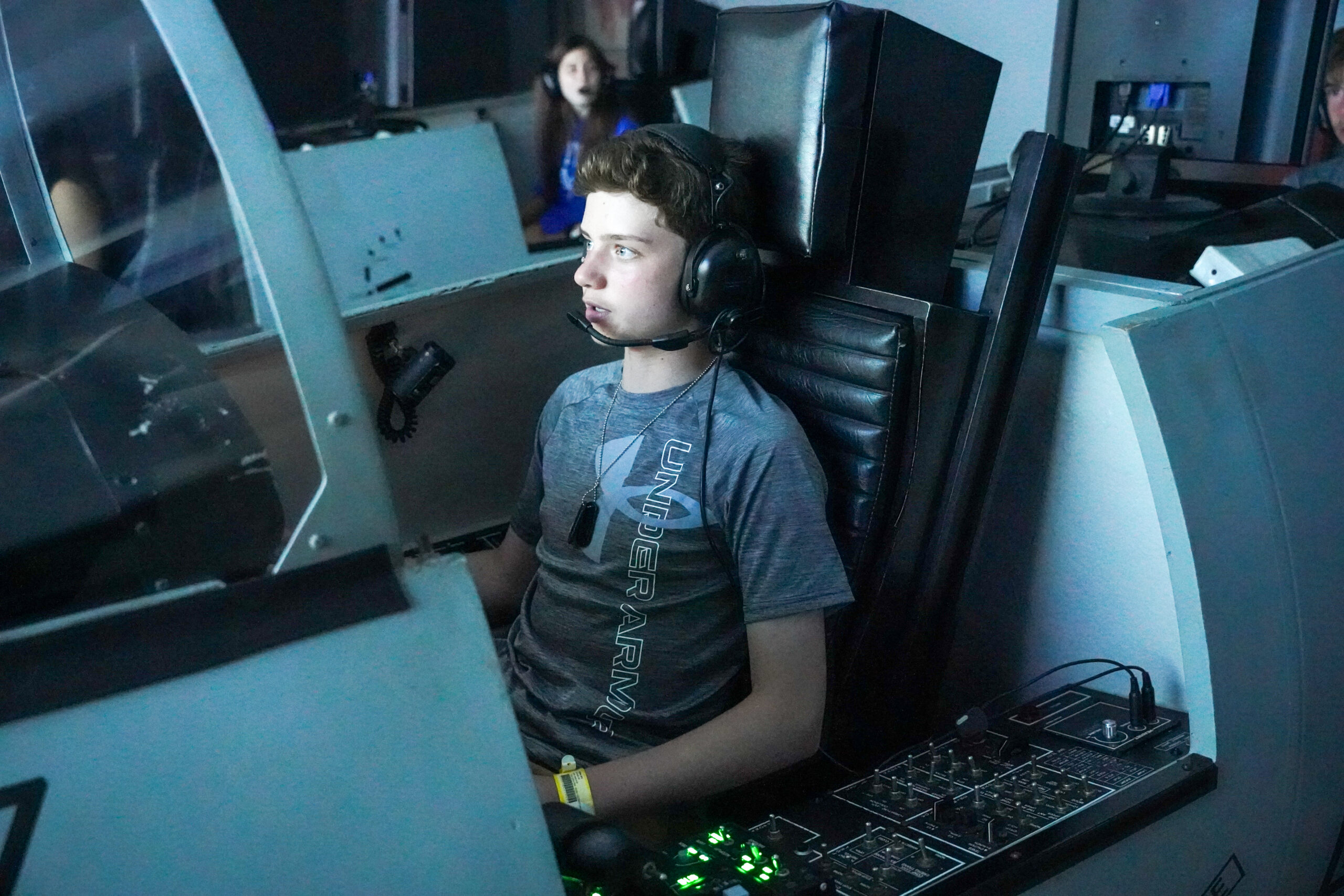Each summer, students across the country step into STEM camps and internships where they get to explore hands-on learning experiences like launching model rockets, dissecting specimens, and designing prosthetic limbs. Along the way, many connect with new ideas about science, technology engineering and math (STEM), how they see themselves in STEM and even what they want to do with the rest of their lives.
At STEM Next, we believe summer is one of the most powerful (and often overlooked) windows for career-connected learning. We know that with the right opportunities, young people can turn curiosity into clarity, build real-world skills, and see where STEM can take them.
Hear it from these three members of our 2025 Flight Crew—John from Maryland, Kandake from Illinois, and Jackson from Michigan—whose summer experiences have helped shape their career goals and prepare them for what’s next.
John’s Story: Building a Future in Aerospace Engineering
 At nine years old, John’s summer experience at Space Camp sparked a passion for aerospace that he’s carried with him ever since.
At nine years old, John’s summer experience at Space Camp sparked a passion for aerospace that he’s carried with him ever since.
“Imagine being so engaged at summer camp that you couldn’t sleep because you didn’t want to miss anything,” he said. “That was my experience at Space Camp.”
From standing beside towering rockets to flying F-15 simulators, these exciting activities helped John realize for the first time that he wanted to pursue a career in aerospace engineering.
Over the years, John continued participating in summer learning experiences to explore his interests, build his skills and expand his network. Now in high school, he’s actively preparing for his future during summer break.
One of his most formative experiences was the Society of American Military Engineers’ Engineering and Construction Program. There, John and his team tackled real-world challenges—like building a doghouse designed to withstand the Colorado winter, which was later donated to a local shelter.
“Knowing that I helped make a dog’s life a bit more comfortable warmed my heart,” he said. Plus, he learned through hands-on experience different ways to collaborate, problem-solve, and lead. “The experience gave me the confidence to tackle tasks and go outside my comfort zone.”
During a summer internship at NASA’s Aviation Systems Division, he applied those experiences to aviation sustainability research and had the rare opportunity to present findings to a panel of NASA engineers and publish his team’s work.
“Working with industry subject matter experts in my desired career field as a high school student is a priceless experience,” he said.
These hands-on opportunities have helped John build critical durable skills, including public speaking and perseverance, and exposed him to tools like Python and Excel in a team setting.
This summer, John is continuing his learning journey by starting ground school and logging flight hours toward his private pilot’s certificate.
Kandake’s Story: Finding her Calling in Healthcare
 Kandake had always been curious about medicine, drawn to the way science and care come together to help people. But it wasn’t until she enrolled in a series of hands-on summer programs focused on biology and health careers that she began to see where that curiosity could lead.
Kandake had always been curious about medicine, drawn to the way science and care come together to help people. But it wasn’t until she enrolled in a series of hands-on summer programs focused on biology and health careers that she began to see where that curiosity could lead.
In one camp, she studied the fundamentals of biology through dissections and microscope work. In another, she explored medical careers while learning to take vital signs and witnessing how technologies like exoskeletons help patients regain mobility. These immersive experiences helped her see herself in the field—not just studying science, but using it to care for others.
By the end of the summer, her path was clear. After a day spent roleplaying as a doctor and caring for infant patients, she got in the car, pulled out her notebook, and wrote: “I want to be a doctor. Not just any doctor, but a pediatrician.”
Beyond sparking her career goals, the programs helped Kandake build real skills. She practiced observation, communication, and clinical basics like checking breathing and recording patient data. These are skills she now sees as essential stepping stones toward her future.
“Before the camps, I had ideas about medicine, but I wasn’t sure what path I wanted to take,” she said. “Getting hands-on experience and learning directly from professionals made everything clearer.”
This summer, Kandake is taking the next step through the I Am Able program, which connects aspiring healthcare professionals with mentors and real-world career exposure.
Jackson’s story: Turning Curiosity Into Confidence in Biomedical Engineering
 Before attending summer STEM programs, Jackson wasn’t quite sure what engineers did—or how many different types of engineering careers existed. He had a general interest in biomedical engineering, but limited exposure to what that might look like in practice. That changed when he attended an Engineering 101 summer program at Michigan Tech, where each day introduced him to a new discipline.
Before attending summer STEM programs, Jackson wasn’t quite sure what engineers did—or how many different types of engineering careers existed. He had a general interest in biomedical engineering, but limited exposure to what that might look like in practice. That changed when he attended an Engineering 101 summer program at Michigan Tech, where each day introduced him to a new discipline.
He explored a range of fields and developed a stronger sense of what engineering looked like in the real world. The highlight came during a hands-on project to build a model of a human limb—complete with nerves, tendons, and blood vessels—then simulate an injury and design a working prosthetic. The experience connected classroom science to real-world problem-solving and sparked deeper curiosity.
That momentum continued when Jackson participated in a training camp for the Chief Science Officer program in his city, where he helps lead STEM clubs across local middle schools. There, a conversation with a visiting biomedical engineer helped him put the pieces together.
“When they talked about what they did and who they worked with, I knew right then that I wanted to do the same thing,” he said.
More than anything, these programs gave Jackson confidence. He learned how to speak with professionals, articulate his interests, and see himself as a peer in STEM conversations.
“Sometimes when I would talk to adults I’d get quieter and not engage as much,” he said. “Going to the training camp and the summer youth program really gave me the confidence needed to talk to these professionals.”
This summer, Jackson is continuing his leadership journey through the Chief Science Officer program—a peer-led initiative that, like the Flight Crew, empowers youth to elevate STEM opportunities in their communities.
Why These Stories Matter
John, Kandake, and Jackson represent millions of young people whose career paths are shaped in out-of-school-time settings through programs that give them a chance to explore, experiment, and imagine futures they might not otherwise see.
Their stories reflect the power of the Career-Connected Learning Framework, a practical guide developed by STEM Next to help summer and afterschool programs spark career exploration, build durable skills, and connect youth with mentors and opportunities that can change lives.
But far too many students still don’t have access to these kinds of experiences.
With the support of our partners, we’re working to change that.


